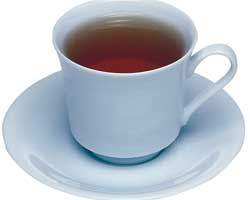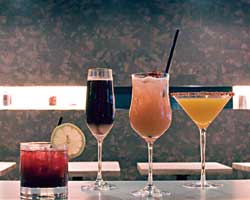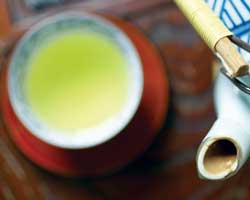
Americans are embracing tea in larger numbers, yet little of it is drunk in American restaurants.

The reason? Inattention to purchasing and execution. Here’s how to get up to speed.
Tea is graded according to the size, shape and quality of the leaves. Whole leaves are generally prized, while tea “dust” is used in inexpensive tea bags. Fine tea leaves are often twisted into shapes for enhanced flavor and better brewing. With top-quality tea, only the bud and top two leaves are harvested; cheaper teas use more of the lower leaves. Just like fine wine, where tea is grown is very important. Some top regions, like Darjeeling (Nepal), Keemun (China) and Assam (India) are justly famous. So-called single-estate teas, grown on a single plantation, are also prized.
Although tea bags have always been handy to use, rarely did they brew top-quality tea. Now a new generation of high-tech bags offers fine, whole leaves with the same convenience. Even so, most tea-lovers, and the restaurants that cater to them, take the time and trouble to brew from loose leaves. The amount needed depends upon the
tea you’re brewing, but start with a heaping teaspoon per six-ounce cup and adjust to taste. Don’t brew with boiling water (212°F)—it should be about 180°F or slightly below the boiling point—and always start with fresh, cold water. Steeping times also vary; try about five minutes and adjust. Remove the leaves immediately. Tea will keep for about a year from date of production, not purchase date. Store in a dark, dry, airtight container.

Tea Cocktails at Santuary Tea
TeaTails
Is tea the new pomegranate? It seems to be showing up on more cocktail menus. In San Francisco, Bar Drake mixologist Jacques Bezuidenhout creates his El Draqui Punch with chai tea; Blackberry Sake Iced Tea is on the list at Poleng Lounge. And Joie de Vivre Hotels stir up a White Lotus Martini with White Lotus Vodka and chamomile tea.
Tea is the star at the aptly named Sanctuary Tea in New York. A teahouse during the day, serving over 60 varieties of tea as well as food, it morphs into a lounge at night, where mixologist Benoit Cornet offers a dozen tea cocktails ($12 each). The list includes the Moroccan Geisha, made with Moroccan mint tea, Jack Daniels, peppermint and simple syrup; Cava de Cama Elderflower, a blend of chamomile tea with Spanish sparkling wine; and the Autumn Chai, which stars chai tea, Poire Williams and Pomme Williams. To make the cocktails, tea is brewed using less water for greater concentration of flavor.

Types of tea
All true tea comes from the Camellia sinensis evergreen. There are some 3,000 varieties, but the main difference between teas is the level of processing.
Black.The most common type, black tea is rolled to release juices then oxidized and fermented before drying; it’s dark green in color with a rich taste.
Green. These tea leaves are simply withered, then steamed to prevent oxidation and dried. Less processing means a lighter color and grassy flavor.
Oolong.This is a semi-fermented cross between green and black, undergoing a small amount of oxidation. It has a slightly smoky aroma and flavor.
White.Also called China, this is the rarest of teas. Only the buds are picked; fine hairs give them a silvery look. Brewed white tea is almost colorless, with a creamy or nutty flavor.
Pu-erh.This unique tea is double-fermented and mold is allowed to grow, imparting a strong, earthy flavor. Pu-erh is drunk mostly for medicinal purposes.
Flavored.Many teas have been flavored with flowers, such as rose and hibiscus, or citrus peel or berries. Chai is black tea with a blend of spices, such as cardamom and cinnamon.
Rooibos.Also called red tea, this is not a true tea; it’s from a South African shrub. The tea has a sweet, nutty flavor.
Tisanes. Often called herbal teas or infusions, these are brewed from dried herbs, flowers and spices.
Members help make our journalism possible. Become a Restaurant Business member today and unlock exclusive benefits, including unlimited access to all of our content. Sign up here.